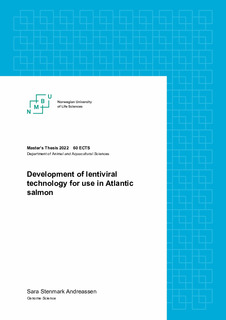| dc.contributor.advisor | Harvey, Thomas Nelson | |
| dc.contributor.advisor | Sandvik, Guro Katrine | |
| dc.contributor.advisor | Torgersen, Jacob Seilø | |
| dc.contributor.author | Andreassen, Sara Stenmark | |
| dc.date.accessioned | 2023-01-05T11:43:38Z | |
| dc.date.available | 2023-01-05T11:43:38Z | |
| dc.date.issued | 2022 | |
| dc.identifier.uri | https://hdl.handle.net/11250/3041192 | |
| dc.description.abstract | Lentiviral vectors are used to deliver and stably integrate genetic material into the genome of cells. When combined with CRISPR based gene editing technology, targeted editing of one or many host genes in a pooled format is possible, enabling massively parallel genetic screens. While this technology is commonplace in mammalian systems, non-mammalian non-model systems such as Atlantic salmon, lag behind. Atlantic salmon (Salmo salar) is one the most economically important farmed fish species, with one of the main constraints for continuous economic growth being infectious diseases. It is desirable to develop an effective method of gene editing and screening for candidate disease resistance genes in Atlantic salmon, such as lentiviral mediated genome wide CRISPR-Cas9 knockout screens. So far there has been limited success in lentiviral transduction of salmon. In this thesis we aim to enable lentiviral transduction of Atlantic salmon cells by identifying which steps in the process are preventing transduction. Confocal microscopy of Atlantic salmon kidney cells transduced with labeled virus revealed that the virus appears to be able to bind and form endosomes in salmon cells. It is unclear if the virus is able to fuse, but no reverse transcriptase activity was detectable by qPCR. Altering temperature and pH had no effect on that transduction of salmon cells, although lowering pH before transduction did increase transduction efficiency in human cells. We also created pseudotyped lentiviral vectors using glycoproteins derived from infectious hematopoietic necrosis virus (IHNV) and viral hemorrhagic septicemia virus (VHSV) and fusions of IHNV and VHSV glycoproteins with commonly used vesicular stomatitis virus glycoprotein. We found that two of the viruses pseudotyped with glycoprotein fusions were capable of transducing human cells, however we were unable to produce successful transduction of Atlantic salmon using any of the pseudotyped vectors. | en_US |
| dc.language.iso | eng | en_US |
| dc.publisher | Norwegian University of Life Sciences, Ås | en_US |
| dc.rights | Attribution-NonCommercial-NoDerivatives 4.0 Internasjonal | * |
| dc.rights.uri | http://creativecommons.org/licenses/by-nc-nd/4.0/deed.no | * |
| dc.subject | Atlantic salmon | en_US |
| dc.title | Development of lentiviral technology for use in Atlantic salmon | en_US |
| dc.type | Master thesis | en_US |
| dc.description.localcode | M-GS | en_US |

